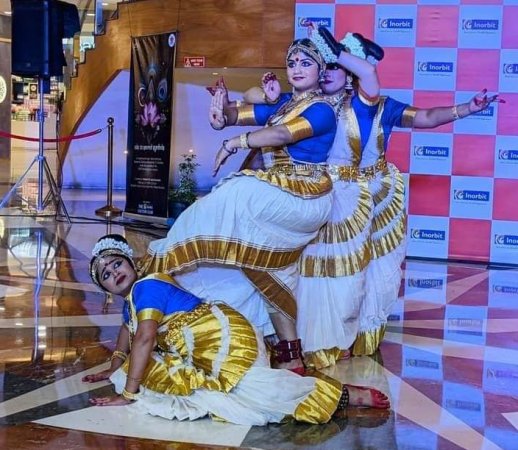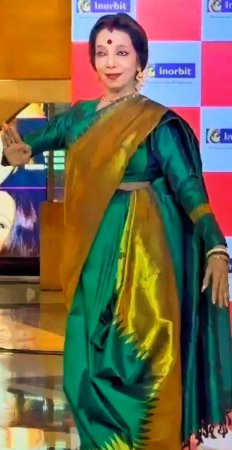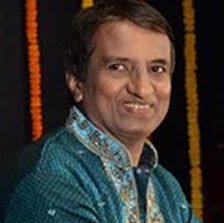
|   |

|   |
An ode to sacred symbols - Vijay Shanker e-mail: vijaydance@gmail.com March 19, 2024 Symbols adorn our world and mind at every sphere of life. India's sages and seers have created symbolic imagery, transforming mudras (hand gestures) into instantly recognized emblems and transmitters of a deity's power or a particular frequency of energy. Each of the dozens of deities in the Hindu pantheon conveys a cosmic function, force or capacity. Today this ancient magic is carried forward in a multitude of ways, from the temple priest's invocation to the Indian housewife's drawing of multi-colored designs, called kolams or rangoli, on the ground as auspicious auguries, household blessings and greetings. It was this that inspired the theme for Feb 3, 2024. "Although malls are the Indraprasth of today that had something for every seeking heart, what it needed was the Arts and thanks to Sandip Soparrkar and GM Satyajit Kotwalji, my dream processed out to a reality which was to have the general public who frequent malls to connect to the finer aspects of life," said Dr Lata Surendra, curator of the unique 'Ode to Sacred Symbols' that brought together several dancers in different styles, exploring the divine significance of every symbol. With the Inorbit Culture Club as the venue partner in Malad, Mumbai, the unique event that had 150 participating professionals took shape at the extraordinary venue under the umbrella of the NCPA Mumbai Dance Season, with the aim being to have more rasikas connect to the rich spectrum of Indian classical dance forms. The traditional lamp lighting by Sandip Soparrkar, Dr Swapnokalpa Dasgupta, senior gurus and other luminaries present set the prelude to the beautiful chapter. The positive message that Sandip Soparrkar highlighted, bespoke of a concern for unity vital in this world today and artistes as those responsible mediums who could highlight it most effectively. The anticipation in onlookers who thronged to witness the show was obvious. The sacred symbol of Chakra, Vishnu's symbol as the wheel of time by Nalanda Nritya Kala Mahavidyalaya set the flow, directed by Dr. Uma Rele. The dancers through the synergy of three dance forms elaborated interestingly, the Kaal chakra concluding with Abhimanyu's Chakravyuh - a formidable military structure that resembled a labyrinth of several defensive walls. The evocative exploring through an interesting choreography that endorsed the beauty of three styles -Bharatanatyam, Kathak and Mohiniattam - rooted the moving crowd of the Inorbit Mall to stillness! Guru Keka Sinha of Kalapi Centre of Performing Arts with Somangka Bhattacharjee presented Kannadibimbam - the Mirror. The mirror is worshipped as the manifestation of the wrathful merciless Bhadrakali, who emanated from the third eye of lord Shiva to vanquish demon Darika accorded with the boon of immortality by Brahma. Senior Manipuri exponent and teacher Latasana Devi, the senior disciple of Darshana Jhaveri, through 'Prarthana' highlighted the significance of Tilaka. With the flowing grace that is Manipuri, she highlighted why staunch Vaishnava devotees wear tilak on twelve parts of the body. Dr Sailaja Desai (Kuchipudi) and Dr Suman Badami (Bharatanatyam) explored the echoes of Dharma unravelling the symbolism of Lord Krishna's conch Panchajanya, . Imagery of Shankh through Andal's Nachiar Tirumozhi - karpuram narumo - and Kurukshetra battle scene where the Lord sounded his conch, brought to life the symbol of the conch.  Disciples of Guru Manisha Jeet Disciples of Guru Manisha Jeet and Manas Cultural Institute with absolute soulful energy of Kathak featured Kasturi Tilakam from Sri Krishna Karnamrutham. Odissi exponent Dr Sarmishta Chattopadhyay explored sandal paste (chandan) through an Odia song by poet Upendra Bhanja, wherein a young gopi comforts her Krishna with a garland of soft malli flowers to soothe him by applying sandal paste. Dr Ayswaria Wariar explored ankusa -the goad of Bhadrakali - and began interestingly with the Kerala temple ritual of kalamezhuthu paattu concluding with creation of Bhairavi from Shiva's third eye.  Disciples of Purbita Mukherjee The sound of the reed comes from fire, not wind, and disciples of Purbita Mukherjee explored the sacred flute. Seasoned Kathak exponent Isha Kathavate explored the Shree Yantra - supreme mystical mandala - the living yantra and related its distinct geometric symbolism with the kinaesthetic of Kathak. Disciples of Guru Padmini Radhakrishna's Soundarya Natya Kalalaya, explored the bell (Ghanta) used in ritual puja that stimulates the inner ear to remind us that, like sound, the world may be perceived but not possessed.  Disciples of Lata Surendra Upasana Academy of Fine Arts - disciples of Guru Jayshree Nair - reached out with the Star through bhakta Dhruva to awaken all to a lesson of surrendering all worries to the divine. Aditi Nrityalaya - disciples of Guru Lata Bakalkar - explored with commitment the sacred Damru, the two sides of which represented the duality of existence. Ananya Iyer and Megha M Pillai, the disciples of the curator Lata Surendra, took up the peacock as the vehicle or vahana of Lord Subramanya .Though the peacock is noted for its excessive pride which is attributed as a negative trait, the rhythm packed choreography symbolically attributed it as the pride that a seeker of truth should have for Supreme Self and the answering rhythm binding the vahana and the deity reflective of the harmony ever so vital in the universe resounding with Omkaram. Bharatanatyam exponent Sujatha Ramanathan accentuated harmony through the vaak devi - embracing wisdom and creativity. The veena, in addition to representing the arts, serves as a reminder to tune one's heart and mind to live in harmony with others and the world. Ved Dance Academy - Aditi Yadav and Paullumi Mukherjee - awakened all to the saguna and nirguna aspect. Paullumi explored the texture of peetam in the creation of Haridri Ganesha while through the composition of Sant Kabir, Aditi Yadav gracefully set about the awakening of ebullient yellow through the formless.  Disciples of Guru Geetha Vijayshanker Bharata Natya Kalalaya with Anupama Devrajan, the dedicated disciple of Guru Geetha Venkateshwar, explored the dualistic aspect of the sacred symbol Agni. The founder of Geetanjali dance school, Mohiniattam Guru Geetha Vijayshanker's talented disciples evocatively highlighted the ornaments of Lord Shiva through sopana sangeetham. The imaginative choreography invoked the Lord's grace with the crescent moon and sacred Ganga flowing from his matted locks. The theme was once again elaborated by the vibrant disciples of Guru K.V. Rajan, founder of Meenakshi Nritya Vidyalaya. Kalangan Guru Moli Siddharth's disciples imaginatively explored the sacred symbol of the tears of Lord Shiva, Rudraksh. 'Ecological responsibility is not an obligation, once we realize we are all integrated' and this was what was sensitively highlighted through the sacred Vat Vriksha by Taal Mani Pandit Brijraj Misra Foundation. Akshobhya Bharadwaj, who is at the core of the new generation of Kathak dancers, embodied Bhasma through his energetic performance. The creative visualiser Debabrata Pal through the synergy of dance and painting depicted the ardhanarishwara symbol. Kathak exponent Kailasnath Kurup doing his Masters at the Bharata College of Fine Arts, explored the blue lotus garland of Lord Shiva choreographed by the very thinking artiste and researcher Dr Sunil Sunkara. Kathak exponent charismatic Disha Desai and team explored bilva patra.  Lata Surendra The Ode to Sacred Symbols concluded with a stirring definition of Dwaj, the flag, through the lament of a patriot's mother by Lata Surendra, who highlighted to all that the flag is symbolic of our nation's pride and accords unto each of us our very cultural identity. Thus with the promise of new beginnings, the witnessing eyes of the rasikas reached out to waiting life realizing that life is not just about passing moments but about shared moments that take our breath away!  Vijay Shankar is a Kuchipudi and Kathakali exponent, teacher, bilingual journalist, arts critic and actor. |